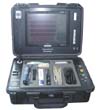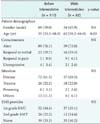Abstract
Objectives
Although ambulance-based telemedicine has been reported to be safe and feasible, its clinical usefulness has not been well documented, and different prehospital management systems would yield different results. The authors evaluated the feasibility and usefulness of telemedicine-assisted direct medical control in the Korean emergency medical service system.
Methods
Twenty ambulances in the Busan area were equipped with a telemedicine system. Three-lead electrocardiogram, blood pressure, and pulse oximetry data from the patient and audiovisual input from the scene were transferred to a server. Consulting physicians used desktop computers and the internet to connect to the server. Both requesting emergency medical service (EMS) providers and consulting physicians were asked to fill out report forms and submit them for analysis.
Results
In the 41 cases in which telemedicine equipment was used, cellular phones were concomitantly used in 28 cases (68.35%) to compensate for the poor audio quality provided by the equipment. The EMS providers rated the video transmission quality with a 4-point average score (interquartile range [IQR] 2-5) on a 5-point scale, and they rated the biosignal transmission quality as 4 (IQR 3-5). The consulting physicians rated the video quality as 4 (IQR 2.5-4) and the biosignal quality as 4 (IQR 3-4). The physicians' ratings for usefulness for making diagnosis or treatment decisions did not differ significantly in relation to the method of communication used.
Conclusions
Our study did not find any significant advantage of implementing telemedicine over the use of voice calls in delivering on-line medical control. More user-friendly, smaller devices with clear advantages over voice communication would be required before telemedicine can be successfully implemented in prehospital patient care.
Telemedicine utilizes information and communication technology to provide healthcare service to individuals who are at a distance from a healthcare provider [1]. Reported applications of telemedicine include doctorless islands, prisons, and inter-hospital consultation [123]. These models require fixed workstations at both sides of the participants and a network connection between the workstations to bring medical expertise to underserved geographic areas [4]. Real-time delivery of audio and video signals allows physical examination over a distance, and it is considered an essential component of telemedicine systems [5]. On the other hand, tele-monitoring of vital signs or biosignals, such as electrocardiogram, may not be incorporated into telemedicine for ambulatory patients [3].
In countries such as Korea and the United States, prehospital care is usually provided by non-physician personnel, and on-line medical direction is required for adequate prehospital care [6]. Ambulance-based telemedicine and telemetry were considered as innovation possibilities in the area of prehospital care, and they have been reported to be safe and feasible [47]. However, the clinical usefulness of telemedicine in urban prehospital care has not been well documented, and different prehospital management systems would yield different results. This study evaluated the feasibility and usefulness of telemedicine-assisted direct medical control in the Korean emergency medical service (EMS) system.
Twenty ambulances in the Busan metropolitan area were equipped with a telemedicine system, named M-KIOSK (PhysioLab Inc., Busan, Korea) (Figure 1). The system is capable of acquiring three-lead electrocardiogram (ECG), blood pressure, and pulse oximetry data from a patient and audiovisual input from the scene. Blood sugar and body temperature were measured with standalone devices, and the results were entered into the M-KIOSK as numerical values. A Wi-Fi network was constructed in each ambulance cabin, and the data were transmitted via high-speed downlink packet access (HSDPA), a kind of third-generation wireless data network. The data were transferred to a server located in the Busan Metropolitan Fire Safety Headquarters, which operates the EMS system. Consulting physicians used desktop computers and the Internet to connect to the server (Figure 2).
Data were collected from August 9, 2009 to September 9, 2009, and consultations were requested using the telemedicine system. Consultation requests made before installation of the telemedicine equipment, between June 1 and June 25, 2009, were used as the control. Both requesting EMS providers and consulting physicians were asked to fill out report forms and to submit them for analysis. The Mann-Whitney test was used to compare continuous data, while the chisquare test or Fisher exact test was used to compare categorical data as appropriate. A p-value of less than 0.05 was considered statistically significant. MedCalc Statistical Software ver. 15.6.1 (MedCalc Software, Ostend, Belgium) were used for analysis.
The numbers of case forms collected from the EMS providers were 82 during the study period and 117 during the control period. The consulting physicians submitted 52 reports during the study period and 87 during the control period. All of the physician-reported cases were matched to EMS provider reports. The basic characteristics of the cases are summarized in Table 1.
Voice calls were used in 100% of cases before the introduction of the telemedicine system, and in only 1 case, there was a final failure to establish a connection. During the study period, the number of attempts to establish connection and the final communication failure rate significantly increased. Consultations for on-scene treatment were significantly reduced by the introduction of telemedicine, while more consultations were made during or after patient transport (Table 2).
In the 41 cases in which telemedicine equipment was used, cellular phones were concomitantly used in 28 cases (68.35%) to compensate for the poor audio quality provided by the equipment. The EMS providers rated the video transmission quality with a 4-point satisfaction score (interquartile range [IQR] 2-5) on a 5-point scale, and they rated the biosignal transmission quality as 4 (IQR 3-5). The consulting physicians rated the video quality as 4 (IQR 2.5-4) and the biosignal quality as 4 (IQR 3-4). The physicians' usefulness ratings for making diagnoses or treatment decisions did not differ significantly in relation to the method of communication used (Table 3).
The results of the study indicate that the introduction of telemedicine shifted the place of medical consultation from the scene to transporting ambulances. Because immediate stabilizing treatments should be provided on the scene before mobilization for transport [8], tele-consultation should be fulfilled at this stage. However, consultation from the scene of a patient encounter was impractical because the size and weight of the telemedicine equipment was not suitable for being carried to the scene, and the access point for data transmission was located in the cabin of the ambulance. The size of the telemetry equipment and the physician-side terminal should be reduced for routine practical use. Additionally, there were difficulties in establishing connections with the telemedicine system. This is partly due to the limited availability of connection lines and the complexity of the system. Repeated communication failure and retrials would consume valuable time for field treatment. If an EMS provider can 'broadcast' consultation requests and any physician who is available can answer the request, rather than using the current method of designating a physician before a call is made, the success rate of establishing communication would be improved.
Our study did not find any significant advantage of telemedicine over voice calls in delivering on-line medical control. A large proportion of information acquired by telemedicine equipment can also be delivered over voice communication without sophisticated technology: heart rate, blood pressure, respiratory rate, and oxygen saturation can simply be spoken over the telephone, for example. Real-time audiovisual input might be helpful for physicians making decisions based on physical finding of the patients [5]. However, the limited bandwidth of the third-generation network and insufficient image processing power of the equipment seem to be obstacles to effective physical diagnosis. Kim et al. [9] suggested that over 600 kbps of bandwidth would be required for real-time telemedicine applications. The average upload speed over HSDPA has been reported to be around 300 kbps [10], and the suboptimal result of the current study may be, at least partly, due to the insufficient network performance of the study period.
Certainly, telemedicine has the ability to deliver continuous ECG waveform, which is reported to help diagnosing certain kinds of arrhythmias [11]. However, ECG telemetry for prehospital diagnosis of arrhythmias is of limited value because antiarrhythmic treatment is not allowed to be applied by EMTs in Korea. Prehospital telemetry would be valuable as a part of pre-arrival notification, allowing hospital emergency staff members to be informed and prepared in advance, rather than providing prehospital treatment. For pre-arrival activation of proven clinical benefit, a 12-lead ECG, rather than continuous rhythm strips, is required [1213].
Although telemedicine technologies are considered promising, most telemedicine applications have failed to survive beyond the funded research phase to be embedded as methods of routine healthcare delivery [14]. Our case is considered to be no exception. Since telemedicine applications usually require additional effort and technical expertise, the use of telemedicine means more time and trouble than practicing in the ordinary way [14]. More user-friendly, smaller devices with clear advantages over voice communication would be required before telemedicine can be successfully implemented in prehospital patient care. The latest smartphones are much smaller, have greatly improved image-processing ability, and are capable of faster data transfer over the fourthgeneration network. Further studies and trials with improved devices and possibly with newer accessories, such as Google Glass, may prove prehospital telemedicine useful in near future [1516].
In conclusion, this study applied an ambulance-based telemedicine system to the EMS service of a metropolitan city and found no apparent benefit over conventional cellular phones, partly because of insufficient technology. Improvement in both the EMS system and information technology would be required for advancement in prehospital care with telemedicine.
Figures and Tables
 | Figure 2Outline of the ambulance-based telemedicine system. EMT: emergency medical technician; HSDPA: high-speed downlink packet access. |
References
1. Roine R, Ohinmaa A, Hailey D. Assessing telemedicine: a systematic review of the literature. CMAJ. 2001; 165(6):765–771.
2. Park IC, Cho JH, Kim SH, Kim DK, Yoo SK, Oh JH. Design of a multimedia telemedicine system for interhospital emergency consultation. J Korean Soc Emerg Med. 2003; 14(5):467–474.
3. Yoon DH, Kim SP, Kim SJ, Cho SH, Cho NS. Influence on a doctorless island residents' health care utilization by video telemedicine. J Korean Soc Emerg Med. 2008; 19(4):359–365.
4. Yperzeele L, Van Hooff RJ, De Smedt A, Valenzuela Espinoza A, Van Dyck R, Van de Casseye R, et al. Feasibility of AmbulanCe-Based Telemedicine (FACT) study: safety, feasibility and reliability of third generation inambulance telemedicine. PLoS One. 2014; 9(10):e110043.

5. Latifi R, Weinstein RS, Porter JM, Ziemba M, Judkins D, Ridings D, et al. Telemedicine and telepresence for trauma and emergency care management. Scand J Surg. 2007; 96(4):281–289.

6. Hwang SO, Lee CC, Singer AJ, Kim TM. The current status of the emergency medical system in Korea. Am J Emerg Med. 2007; 25(7):846–848.

7. Galli R. Innovation possibilities for prehospital providers. Prehosp Emerg Care. 2006; 10(3):317–319.

8. Beuran M, Paun S, Gaspar B, Vartic N, Hostiuc S, Chiotoroiu A, et al. Prehospital trauma care: a clinical review. Chirurgia (Bucur). 2012; 107(5):564–570.
9. Kim DK, Yoo SK, Jung SM, Kim NH. Evaluation of webbased real-time telemedicine application using ActiveX controls for medical moving picture analysis. J Korean Soc Med Inform. 2003; 9(3):261–267.

10. Banitsas K, Tachakra S, Stefanidis E, Boletis K. Using HSPA to improve the telemedical links on a moving ambulance. Conf Proc IEEE Eng Med Biol Soc. 2008; 2008:739–742.

11. Hollander JE, Delagi R, Sciammarella J, Viccellio P, Ortiz J, Henry MC. On-line telemetry: prospective assessment of accuracy in an all-volunteer emergency medical service system. Acad Emerg Med. 1995; 2(4):280–286.

12. Dhruva VN, Abdelhadi SI, Anis A, Gluckman W, Hom D, Dougan W, et al. ST-Segment Analysis Using Wireless Technology in Acute Myocardial Infarction (STATMI) trial. J Am Coll Cardiol. 2007; 50(6):509–513.

13. Campbell PT, Patterson J, Cromer D, Wall K, Adams GL, Albano A, et al. Prehospital triage of acute myocardial infarction: wireless transmission of electrocardiograms to the on-call cardiologist via a handheld computer. J Electrocardiol. 2005; 38(4):300–309.

14. Zanaboni P, Wootton R. Adoption of telemedicine: from pilot stage to routine delivery. BMC Med Inform Decis Mak. 2012; 12:1.





 PDF
PDF ePub
ePub Citation
Citation Print
Print






 XML Download
XML Download